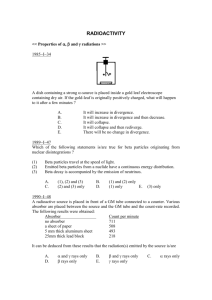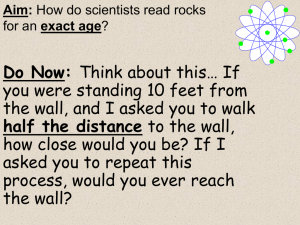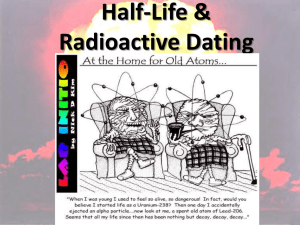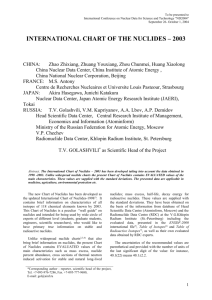Ch. 18 Nuclear Chemistry
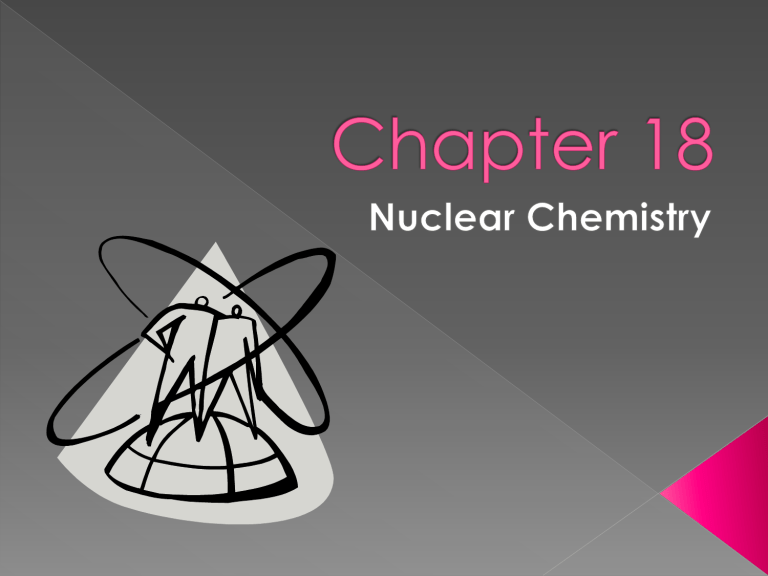
So far we’ve studied chemical reactions where only electrons have changed.
Chemical properties are determined by electrons!
›
›
Nucleus was not primarily important in these reactions, as it did not undergo any changes.
Identities remained the same in chemical reactions because protons remained the same.
This is no longer true in nuclear reactions!
Nucleus is extremely small, dense, and contains a huge amount of energy.
› Millions of times more E than chemical reaction.
Nucleus = neutrons + protons
› Made of even smaller parts, such as quarks.
A
Z
X where A = mass # & Z = charge/# of protons.
› Isotopes = atoms of the same element with different #’s of neutrons (protons stay the same).
Radioactive Decay &
Nuclear Stability
Already discussed these in the packet you completed.
Additional note: decay types can be broken into two categories: those that change mass # and those that don’t.
Changes mass #: alpha emission.
› Giving off a He atom decreases mass.
›
Example: 238
92
U 4
2
He + 234
90
Th
This is a type of spontaneous fission – splitting a heavy nuclide into 2 lighter nuclides.
Do not change mass #: particle emitted/used has no mass (mass # = 0).
Beta emission: 131
53
I 0
-1 e + 131
54
Xe
Gamma ray emission:
238
92
U 4
2
He + 234
90
Th + 0
0
Positron emission:
22
11
Na 0
1 e + 22
10
Ne
Electron capture:
201
80
Hg + 0
-1 e 201
79
Au + 0
0
Radiation emitted has different levels of penetration.
The more penetrating the emission, the more dangerous.
The order is as follows:
alpha < beta/positron < gamma ray
Therefore, alpha particles are least penetrating and gamma rays are by far most penetrating.
Which of the following statements is true about beta particles?
a) They are electrons with a mass number of
0 and a charge of -1.
b) They have a mass number of 0, a charge of -1, and are less penetrating than α particles.
c) They are electrons with a charge of +1 and are less penetrating than α particles.
d) They have a mass number of 0 and a charge of +1.
When 226
88
Ra decays, it emits 2 α particles, followed by a β particle, followed by an α particle. The resulting nucleus is: a) b)
212
222
83
Bi
86
Rn c) 214 d) 214
82
Pb
83
Bi
Total of 3 α particles, so subtract 12 from mass # and 6 from atomic #: 214
82
Pb
β particle means get rid of a neutron and add a proton (and an electron): 214
83
Bi
The formation of 230
90
Th from 234
92
U occurs by: a) Electron capture.
b) α decay.
c) βdecay.
d) Positron decay.
An atom of 238 decay by α emission. What is the product nuclide?
92
U undergoes radioactive a) b) c) d)
230
90
234
90
230
230
92
91
Th.
Th.
U.
Pa.
If a nucleus is unstable it will undergo radioactive decay to become stable.
Can be tricky to determine if a nuclide is stable and how it will decay, but several generalizations have been.
› Note: nuclide = a specific nucleus of an isotope or atom.
Of 2000 known nuclides, only 279 are stable.
› Tin has the greatest number of stable isotopes at 10.
Ratio of neutrons: protons determine stability.
• What is the stable ratio of n:p + at the lower end of the belt?
• What is the stable ratio of n:p + at the upper end of the belt?
• Based on this information, what can you conclude about the ratio of n:p + in stable nuclides?
• This can be found on pg. 842 in your textbook.
Developed by plotting # of neutrons vs. # of protons of known, stable isotopes.
Low end of the belt shows a stable ratio of about 1n:1p + .
As the belt gets higher (more protons), the stable ratio begins to increase to about 1.5n:1p + .
For isotopes with less than 84 p + , the ratio of n:p + is a good way to predict stability.
For light nuclides (<20 p + ), 1:1 ratio of n:p + are stable.
For heavier nuclides (20 to 83 p + ) ratio increases (to ~1.5:1).
›
›
Why?
More neutrons needed to stabilize repulsive force of more protons.
All nuclides with 84 or more p + are unstable (because they’re so big).
› Alpha decay occurs- giving off a He atom lessens both mass and atomic #.
Even #’s of n & p + are more stable than odd #’s.
Pg. 843 in textbook
Magic Numbers: certain #’s of n or p + give especially stable nuclides.
2,8,20,28,50,82,126
›
›
›
A nuclide with this number of n or p + would be very stable.
If there is a magic number of n & p + , this is called a double magic number (usually seen in heavier nuclides were extra stability is needed).
The stability of magic numbers is similar to atoms being stable with certain #s of e -
2(He), 8(Ne), 18(Ar), 36(Kr), 54(Xe), 86(Rn)
1) Is the isotope Ne-18 stable?
› 10p + and 8n 0.8:1
›
›
Ratio is <1:1, so it is unstable!
Undergoes decay to either increase
#n & decrease #p +
2) Is the isotope
12
6
C stable?
Yes! Ratio = 1:1 (also even # n & p + ) ›
3) Is the isotope sodium-25 stable?
›
›
›
Ratio of n:p + = 14:11 1.3:1
Not stable! How will it become stable?
Decrease #n beta emission
Pg. 869 #3, 4, 12, 13, 20
The Kinetics of Radioactive Decay
Rate of decay = - change in #of nuclides change in time
›
›
Negative sign = number decreasing
Tough to predict when a certain atom will decay, but if a large sample is examined trends can be seen.
Trends indicate that radioactive decay follows first-order kinetics.
Thus first-order formulas are used!
Two formulas are used to solve calculations involving decay and half-life:
ln[A] t t
1/2
– ln[A]
= ln2 k
0
= -kt
• Usually takes 10 half lives for a radioactive sample to be ‘safe’.
• Half-lives can be seconds or years!
Formulas above are used when multiples of half lives are not considered.
Example #1: I-131 is used to treat thyroid cancer. It has a half life of 8 days. How long would it take for a sample to decay to 25% of the initial amount?
Each half-life cycle decreases the initial amount by half: after 8 days, one halflife, 50% remains. After another 8 days,
25% remains. Thus it would take 16 days.
Every half-life cycle will follow the following order of percentages of radioactive isotopes that remain :
100%, 50%, 25%, 12.5%, 6.25%, 3.12%, etc.
If a question asks about half-life and involves one of these ‘easy’ percentages, you can simply count how many half-life cycles have occurred.
However, not all are this simple!
Example #2: What is the half-life of a radioactive isotope (radioisotope) that takes 15min to decay to 90% of its original activity?
90% is not a multiple of half-life cycles, so we need to use the previously mentioned equations to calculate this.
Steps:
(1) Use ln[A] t
– ln[A] constant, k.
0
= -kt to solve for the rate
(2)
• Often times specific amounts/concentrations will not be given! Usually given as percentages of original sample left over. Just assume 100 as the original ([A]
0
) and use the percent asked about as [A] t
.
Then use t
1/2 to solve for the half life (units will vary depending on what is given in the problem).
Example #2: What is the half-life of a radioactive isotope (radioisotope) that takes
15min to decay to 90% of its original activity?
t ln(90) – ln(100) = -k(15min) k = 0.00702/min
1/2
= ln2/0.00702min
-1 t
1/2
= 98.7min
If both the half-life of a radioactive isotope is given and the amount of radioactive substance remaining, the amount of time it took for this substance to decay to this point can be calculated.
First, use t
1/2 formula to find k.
Then, use other formula to solve for t.
This is how carbon dating (uses radioactive C-14 isotope) is used to determine ages of objects!
If a wooden tool is discovered, and its C-
14 activity has decreased to 65% of its original amount, how old is the tool? The half-life of C-14 is 5,730 years.
5,730yr = ln2/k k = 1.21 x 10 -4 /year ln65 – ln100 = -(1.21 x 10 -4 /year)t t = 3,600 years
During nuclear reactions and nuclear decay, energy is given off.
› Gamma rays, x-rays, heat, light, and kinetic E
Why does E always accompany these reactions?
› Small amount of matter is turned into E.
› Law of conservation of matter is not followed during nuclear reactions!
Einstein’s equation is used to perform calculations involving the mass-energy change in nuclear reactions: E = mc 2 .
›
›
›
E = energy released m = mass converted into energy (units need to be in kg in order to get J as unit of E) c = speed of light = 3.00 x 10 8 m/s
Note that the amount of matter turned into E in a nuclear reaction is small, but is amplified by the speed of light to produce a lot of E!
When one mole of uranium-238 decays into thorium-234, 5 x 10 -6 kg of matter is changed into energy. How much energy is released during this reaction?
E = (5 x 10 -6 kg)(3.00 x 10 8 m/s) 2
E = 5 x 10 11 J
Pg. 870 # 21, 24, 35




